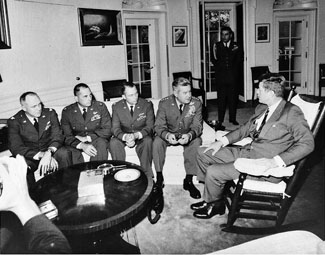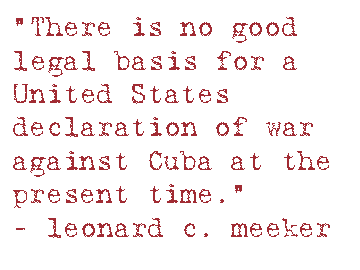Thusday, 18 October 1962
Sometime on the 18th, the USMC EAC was notified of the developments in Cuba by the CIA and began to make arrangements to facilitate the use of Naval Air Station Opalocka during the presumed execution of Operational Plan (OPLAN) 316-61 (CUBA). OPLANs 312-62, 314-61 and 316-61 (CUBA) were to be reviewed by Commander-in-Chief Atlantic (CINCLANT). The EAC also notes that there were no changes in the DEF CON.16 The mobilization of the Pentagon’s war planners to develop a military solution to the Cuban Crisis set the military behemoth on a course leading to war. The generals did not worry about the legitimacy of their actions, nor did they worry about world opinion. Their focus was strictly on how to achieve the objective of neutralizing the threat presented by nuclear missiles in Cuba.
CON.16 The mobilization of the Pentagon’s war planners to develop a military solution to the Cuban Crisis set the military behemoth on a course leading to war. The generals did not worry about the legitimacy of their actions, nor did they worry about world opinion. Their focus was strictly on how to achieve the objective of neutralizing the threat presented by nuclear missiles in Cuba.
In solving the military problem, their problem was time. The generals needed a maximum amount of time to hone their pre-established contingency plans into a workable operations plan and then execute their plan as quickly as possible. The best option available was a rapid air strike to neutralize 100% of the missile sites followed by a full invasion of the island-nation. The generals needed time to marshal the necessary forces into place to effectively conduct the operation; but they needed to do it quickly enough to retain the element of surprise which would then rob the Soviet generals the time required to complete and arm the missiles, or bolster their operational capacity, or establish significant defenses.
Because of the pressures indicated, the generals, once set in motion, remained fixed on options that would best enable the strike and follow-on invasion of Cuba.  Their judgment was clouded because they remained fixed on the military option as the only option. This severely strained their relationship with their civilian bosses and in many ways tested the limits of civilian leadership over the United States military. The military would, from the beginning until beyond the conclusion of the crisis, exert the maximum pressure available on the President to yield to their desires.
Their judgment was clouded because they remained fixed on the military option as the only option. This severely strained their relationship with their civilian bosses and in many ways tested the limits of civilian leadership over the United States military. The military would, from the beginning until beyond the conclusion of the crisis, exert the maximum pressure available on the President to yield to their desires.
Also on the 18th, State Department Legal Advisor Leonard Meeker advised the Secretary of State that he was not convinced of the legality of a blockade and that he was certain that the United Nations Security Council would never support such a measure. Meeker held some hope that the Organization of American States (OAS) could bring forth a chance of legitimacy, but in his view, it would be very difficult to get the requisite two-thirds vote to pass such a resolution.17 On the 19th Leonard Meeker presented his legal opinion about the blockade to the Executive Committee.
The diplomat’s goal in such a conflict is to gain legitimacy for his claim. Meeker’s opinion two days after the crisis began set the stage for the rest of the diplomatic struggle. The direct route – force – would be condemned and held no legitimacy. A quarantine would only have the required legitimacy with the support of an international body such as the OAS.

